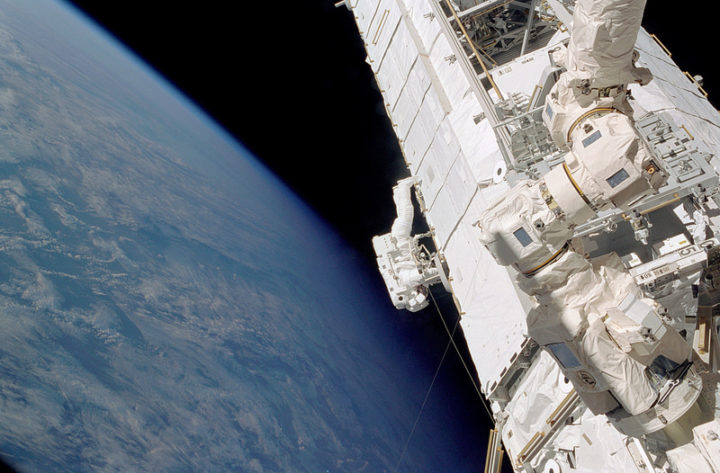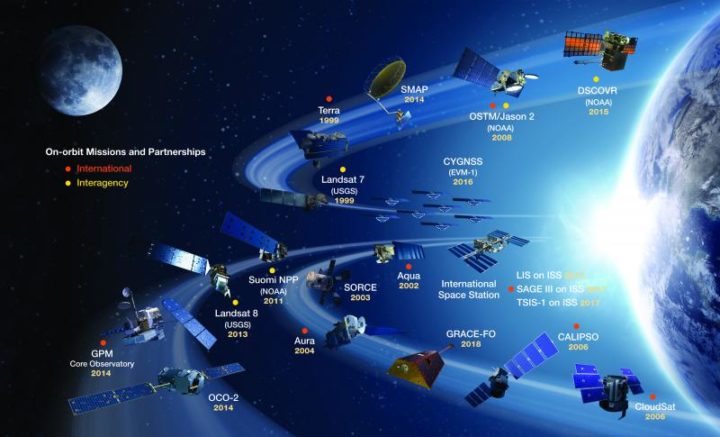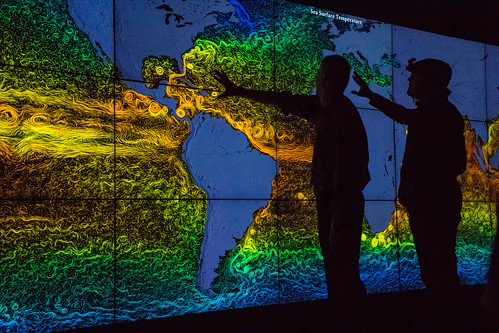
Piers Sellers during a spacewalk outside of the International Space Station. Credit: NASA
Astronaut and scientist Piers Sellers is no longer with us, but his words still resonate.
A posthumous plea from Sellers arrived in July 2018 in the form of an article in PNAS. The topic was one that he cared deeply about: building a better space-based system for observing and understanding the carbon cycle and its climate feedbacks.
As NASA’s Patrick Lynch reported, Sellers wrote the paper along with colleagues at NASA’s Jet Propulsion Laboratory and the University of Oklahoma. Work on the paper began in 2015, and Sellers continued working with his collaborators up until about six weeks before he died. They carried on the research and writing of the paper until its publication in July 2018.
The carbon cycle refers to the constant flow of carbon between rocks, water, the atmosphere, plants, soil, and fossil fuels. Climate change feedbacks—natural effects that may amplify or diminish the human emissions of greenhouse gases—are one of the most poorly understood aspects of climate science.
Here is how Sellers and colleagues characterized the current state of the carbon cycle in the PNAS article:
“It is quite remarkable and telling that human activity has significantly altered carbon cycling at the planetary scale. The atmospheric concentrations of carbon dioxide (CO2) and methane (CH4) have dramatically exceeded their envelope of the last several million years.”
They also explain in detail how we have altered the carbon cycle:
“The perturbation by humans occurs first and foremost through the transfer of carbon from geological reservoirs (fossil fuels) into the active land–atmosphere–ocean system and, secondarily, through the transfer of biotic carbon from forests, soils, and other terrestrial storage pools (e.g., industrial timber) into the atmosphere.”
Scientists understand the broad outlines of how this works relatively well. What worried Sellers was the potential curve balls the climate might throw at us with unanticipated feedbacks. They addressed some of the the challenges in understanding how climate change might affect concentrations of carbon dioxide and methane through feedbacks.
For carbon dioxide:
“While experimental studies consistently show increases in plant growth rates under elevated CO2 (termed carbon dioxide fertilization), the extrapolation of even the largest-scale experiments to ecosystem carbon storage is problematic, and some ecologists have argued that the physiological response could be eliminated entirely by restrictions due to limitation by nutrients or micronutrients. However, there is recent evidence from the atmosphere that suggests increasing CO2 enhances terrestrial carbon storage, leading to the continued increase in land uptake paralleling CO2 concentrations.”
As we detailed in a separate story, the situation is even more complicated for methane. Sellers and his colleagues explained some of the challenges in understanding the feedbacks that affect that potent greenhouse gas this way:
“Atmospheric methane is currently at three times its preindustrial levels, which is clearly driven by anthropogenic emissions, but equally clearly, some of the change is because of carbon-cycle–climate feedbacks. Atmospheric CH4 rose by about 1 percent per year in the 1970s and 1980s, plateaued in the 1990s, and resumed a steady rise after 2006. Why did the plateau occur? These trends in atmospheric methane concentration are not understood. They may be due to changes in climate: increases in temperature, shifts in the precipitation patterns, changes to wetlands, or proliferation in the carbon availability to methane-producing bacteria.”
The consequences of the gaps in understanding could be significant.
“Terrestrial tropical ecosystem feedbacks from the El Nino drove an ∼2-PgC increase in global CO2 emissions in 2015. If emissions excursions such as this become more frequent or persistent in the future, agreed-upon mitigation commitments could become ineffective in meeting climate stabilization targets. Earth system models disagree wildly about the magnitude and frequency of carbon–climate feedback events, and data to this point have been astonishingly ineffective at reducing this uncertainty.”

NASA’s current missions and partnership missions in orbit. Credit: NASA
Sellers and his colleagues do offer a solution. It has much to do with satellites.
“Space-based observations provide the global coverage, spatial and temporal sampling, and suite of carbon cycle observations required to resolve net carbon fluxes into their component fluxes (photosynthesis, respiration, and biomass burning). These space-based data substantially reduce ambiguity about what is happening in the present and enable us to falsify models more effectively than previous datasets could, leading to more informed projections.”
Tags: carbon, feedbacks, satellites




